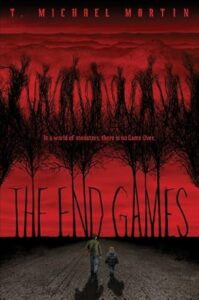Epigraphs
A post at Kill Zone Blog: Epigraphs
I love epigraphs, those sparkling word gems that a writer places at the beginning of the novel. The epigraph is a chance for the author to share what was on his/her mind when writing the book, or perhaps an intriguing hint of what’s to come. If done well, it will compel the reader to turn the page and begin reading.
So do I. I’ve never put any into a novel. I’m not sure why not. I guess it seems weird to me in secondary world fantasy. I do like epigraphs, though!
Ten examples at the linked post, of which my favorite isn’t a quote from a novel, but this one:
THE END GAMES by T. Michael Martin

“Everything not saved will be lost”. –Nintendo “Quit Screen” message
Now, that is just brilliant. I swear, it makes me want to buy the book solely because that’s such a fantastic epigraph! Maybe. Because obviously it’s horror. Is that obvious? It looks like Cormac McCarthy’s The Road, with zombies. That’s what the cover looks like. What is it really? Here’s the description:
John Green meets Stephen King in this original take on the zombie apocalypse by author T. Michael Martin, which ALA Booklist called “the best of the undead bunch” in a starred review.
Seventeen-year-old Michael and his five-year-old brother, Patrick, have been battling monsters in the Game for weeks. In the rural mountains of West Virginia—armed with only their rifle and their love for each other—the brothers follow Instructions from the mysterious Game Master. They spend their days searching for survivors, their nights fighting endless hordes of “Bellows”—creatures that roam the dark, roaring for flesh. And at this Game, Michael and Patrick are very good. But the Game is changing. The Bellows are evolving. The Game Master is leading Michael and Patrick to other survivors—survivors who don’t play by the rules. And the brothers will never be the same.
Yep, zombies.
But, back to epigraphs. An epigraph sets the tone for the novel, right? And implies the theme, or an important theme. In SF novels, you can have epigraphs for the whole novel or at the beginning of each chapter that are from fictional future works, which can be neat. Who’s done great epigraphs? Well, here’s a good example: My Enemy My Ally by Duane — one of my favorite Star Trek novels. Duane used real quotes about Classical Rome plus fictional quotes from Rihansu works, which was a fantastic idea.
From Horatius:
Then none was for a party;
Then all were for the state;
Then the great man helped the poor,
And the poor man loved the great:
Then lands were fairly portioned;
Then spoils were fairly sold:
The Romans were like brothers
In the brave days of old.
Now Roman is to Roman
More hateful than a foe,
And the Tribunes beard the high,
And the Fathers grind the low.
As we wax hot in faction,
In battle we wax cold:
Wherefore men fight not as they fought
In the brave days of old.
vs
Of the chief parts of the Ruling Passion, only this can be said:
Hate has a reason for everything, but love is unreasonable.
I’m not going to type the Rihansu words because that would be a pain, but Diane Duane developed the concept of Mnhei’sahe, which I really noticed and liked at the time. I didn’t realize till just now how CJC’s man’chi is rather similar — I mean the words are rather similar — and the idea that this is an important emotional concept that doesn’t map onto ordinary human emotions is similar.
How about fantasy novels? The Night Circus has a good one:
A dreamer is one who can only find his way by moonlight, and his punishment is that he sees the dawn before the rest of the world. — Oscar Wilde
Piranesi has two:
I am the great scholar, the magician, the adept, who is doing the experiment. Of course I need subjects to do it on. — CS Lewis, The Magician’s Nephew
People call me a philosopher or a scientist or an anthropologist. I am none of those things. I am an anamnesiologist. I study what has been forgotten. I divine what has disappeared utterly. I work with absences, with silences, with curious gaps between things. I am really more of a magician than anything else. — Laurence Arne-Sayles, interview in The Secret Garden, May 1976”
I love those! You know what, I really love epigraphs, I’m deciding. Honestly, I still think they’re hard to do well in secondary world fantasy, but I do love them and maybe eventually I’ll think of adding an epigraph or two in the front of a book.
Here’s a related post at Reactor, and though I still dislike the name of the site, fine, it’s still a related post: Always Read the Epigraph: A Lesson for Fantasy Readers.
I don’t expect you to just take my word for it. Instead, I’m going to talk to you now about two particular fantasy novels—Neil Gaiman’s Neverwhere and Kate Griffin’s A Madness of Angels—that I think illustrate the value of epigraphs. Why these two? Because they demonstrate two opposite but equally effective ways in which an epigraph or two can really spice up a story. …
Click through to check out those epigraphs; it’s a good post.
I actually think, sure, you should pause and read the epigraph before you read the novel. It’s true the epigraph often captures the tone of the coming story.
But you should also come back to it and read it again later, after you’ve finished the novel. That’s when it’ll resonate.
Please Feel Free to Share:






The post Epigraphs appeared first on Rachel Neumeier.



